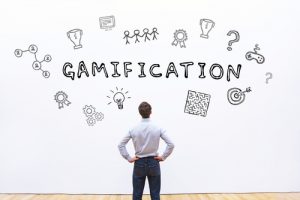By Andy Low

The term Gamification is often confused with the word Game. In this article, I will attempt to clarify the differences as well as to highlight how gamification can be applied to our daily lives and work to improve employee engagement.
The word gamification was first coined by British consultant N Pelling in 2002 for his consultancy business to create game-like interfaces for electronic devices. At that time, he wanted to mean interface design and something quite closely related to game design.
Fast forwarding to today and the word mean a very different thing, it does not simply mean interface design. Far from it, gamification in today’s context is a system or method that can result in positive outcomes and behavioural changes.
To help us understand the two words better, let us start with some definitions to allow you to understand the critical elements of the two words.
Decoding Game Fundamentals

We all know what playing a game is and how addictive it can be, to define what is a game, seem somewhat a more challenging endeavour. Nevertheless, we researched extensively and settled on an all-encompassing definition.
We use a definition which is a combination of the work by Katie Salen and Eric Zimmerman in their book Rules of Play- Game Design Fundamentals, Raph Koster in his seminal work- A Theory of Fun, and Karl Kapp in his book- The Gamification of Learning and Instruction.
A game is a system in which players engage in an abstract challenge, defined by rules, interactivity and feedback, that results in a quantifiable outcome that often elicits an emotional reaction.
Let us go through each of the keywords in this definition to have a better understanding:
System
It consists of interconnected elements that a game designer used within the game. Desirable activities and behaviour will earn players points that are in turn related a strategy or goal. The interconnected elements interact to form the system of the game.
Players
A user that is interacting with the game content or with other users are the players. Here we will use player and user interchangeably, the reason being in a game is that when a player plays the game, they feel good. In a gamified solution, a player or user does not play the game but participate in activities that lead to a desirable outcome. Hence, it will be more appropriate to use the term user in a business context.
Abstract
Games will usually involve an abstraction of reality that takes place in the game environment. A game will contain realistic elements of a situation but not an exact one. The concept of reality usually creates emotions for users while the practical aspects keep the users familiar with the environment.
Challenge
Games must challenge users to achieve goals that are not easy to obtain. Research has shown that if the obstacles are too simple that require little or no effort users will not be motivated to achieve it.
Rules
The rules are instruction and boundaries that users must follow when playing the game. They define the sequence of play, the winning state, what is fair and what is not and the limits of the game.
Feedback
One of the key components of the game is the feedback that they provide to users, and they are usually instant, direct and precise. In employee engagement, this essential component of the game helps companies to provide feedback to employees to the activities. In this way, users take in the input, be it negative or positive, to modify their actions and achieve more positive feedback.
Emotional Reaction
Games will evolve emotion be is the agony of defeat to the excitement of a victory. This emotion is known as a dopamine loop. It is the design of this recurring loop that keeps users coming back for more.
From the definition, it is apparent that to design a “good” game will require a designer to combine all these elements successfully that will magnify the effect of all these elements that on an individual basis will not be able to achieve.
Understanding Gamification

Gamification as a system has undergone a significant and radical change since its early days as interface design.
Today, it is used widely in many different segments like employee engagement and performance, training, health, marketing and to drive innovation.
We like Gartner’s definition most as it encapsulates the essence of what will make gamification works and the desired outcome that it can generate.
Gamification uses game mechanics elements like points system, badges and leaderboard to engage users. The gamified solution uses experience design to create a journey for the users. It uses digital setting and technology to engage users instead of manual and personal engagement. The result of gamification is not fun but to motivate users to achieve the desired outcome.
So while games use fun and challenges as a crucial element to elicit emotion in players to make them feel good. Gamification, on the other hand, focuses on the desired outcome. This outcome importantly must be aligned with the users’ desire so that users will be motivated to engage in the gamified solution.
Application
While games focus on fun, gamification focus on motivation to achieve the desired outcome. As a result, it finds application in the following areas:
- Change behaviour
- Develop skills and learning
- Drive innovation in a group setting
In our daily lives, we can use gamification to help us increase our physical activities. You could use it to help you to lose weight as well. There have been many successful cases where gamification has been used to increase physical activities.
One of the bigger scale successful case is Singapore’s attempt to get the nation to increase physical activities. The project has been implemented successfully under the Health Promotion Board, HPB, whereby citizens are encouraged to take up the step challenge to walk 10,000 steps per day.
Citizens are challenged to increase their daily physical activities, and vouchers will reward the desired outcome. In this way, HPB has been able to motivate citizen to enhance physical activities which are proven to help reduce chronic diseases while at the same time users are rewarded with vouchers for their effort.
From the business aspect, gamification has been successfully used, to increase employee engagement. Engaged employees have shown improvement in companies’ performance. The desired outcome of improving performance for the company and engaging and energising employees is what is motivating more companies to implement this solution in their workplace.
Conclusion
Gamification has also proven to be successful in changing behaviour and developing skills, for both employees and individual. A well-designed solution will be necessary to bring about such an outcome.
In my opinion, companies who are still not familiar with gamification should take the vital step of starting their journey of improving the company’s overall growth and performance by “gamifying” their work process. Here, I improvise from Neil Armstrong’s famous quote- one small step for the employee, a giant leap for the organisation.
In future, the use of data analytics and behavioural science will be able to improve the results of gamification further.
Reference:


